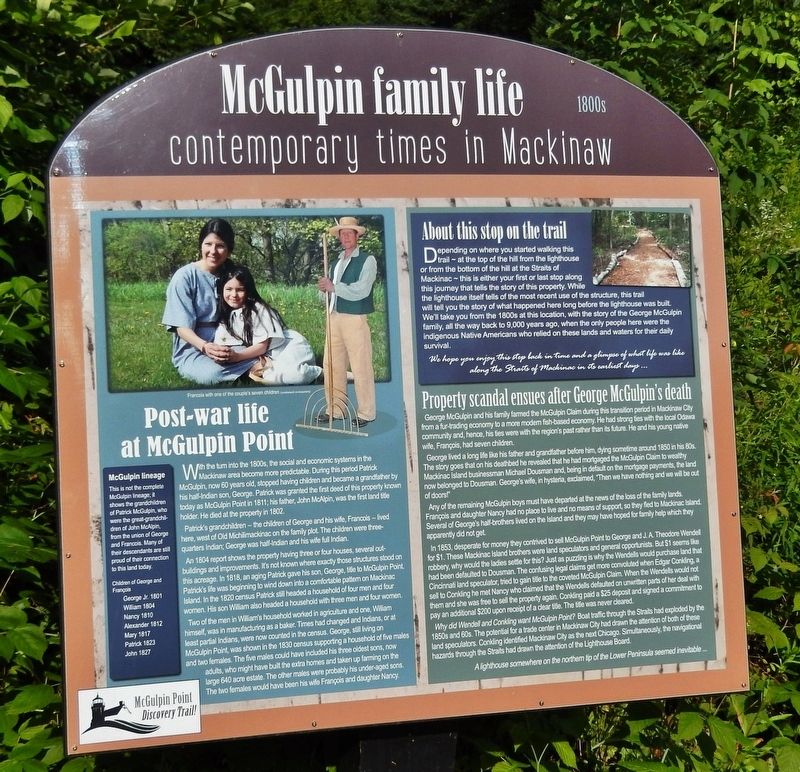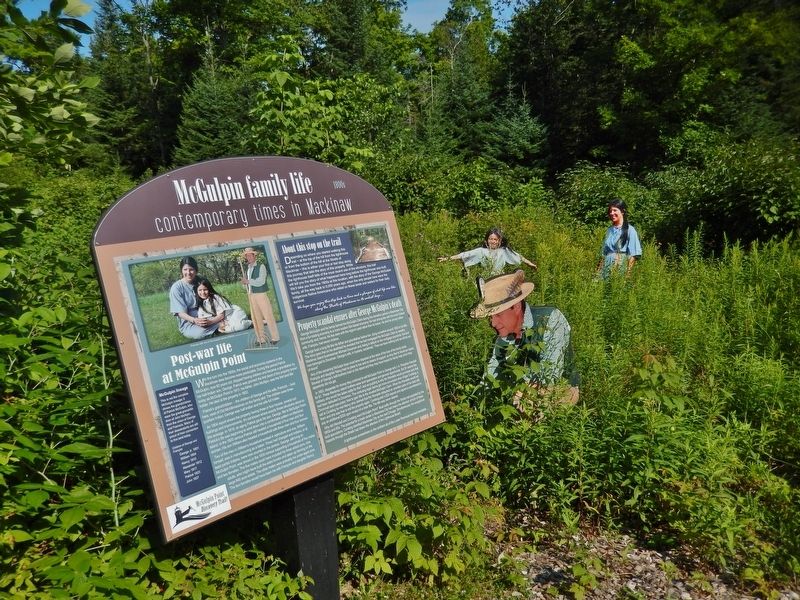Mackinaw City in Emmet County, Michigan — The American Midwest (Great Lakes)
McGulpin Family Life
Contemporary Times in Mackinaw
— 1800s —
With the turn into the 1800s, the social and economic systems in the Mackinaw area become more predictable. During this period Patrick McGulpin, now 60 years old, stopped having children and became a grandfather by his half-Indian son, George. Patrick was granted the first deed of this property known today as McGulpin Point in 1811; his father, John McAlpin, was the first land title holder. He died at the property in 1802.
Patrick's grandchildren — the children of George and his wife, François — lived here, west of Old Michilimackinac on the family plot. The children were three-quarters Indian; George was half-Indian and his wife full Indian.
An 1804 report shows the property having three or four houses, several out-buildings and improvements. It's not known where exactly those structures stood on this acreage. In 1818, an aging Patrick gave his son, George, title to McGulpin Point. Patrick's life was beginning to wind down into a comfortable pattern on Mackinac Island. In the 1820 census Patrick still headed a household of four men and four women. His son William also headed a household with three men and four women.
Two of the men in William's household worked in agriculture and one, William himself, was in manufacturing as a baker. Times had changed and Indians, or at least partial Indians, were now counted in the census. George, still living on McGulpin Point was shown in the 1830 census supporting a household of five males and two females. The five males could have included his three oldest sons, now adults, who might have built the extra homes and taken up farming on the large 640 acre estate. The other males were probably his under-aged sons. The two females would have been his wife François and daughter Nancy.
McGulpin lineage
This is not the complete McGulpin lineage: it shows the grandchildren of Patrick McGulpin, who were the greatgrandchildren of John McAlpin, from the union of George and François. Many of their descendants are still proud of their connection to this land today.
Children of George and François
George Jr. 1801 • William 1804 • Nancy 1810 • Alexander 1812 • Mary 1817 • Patrick 1823 • John 1827
About this stop on the trail
Depending on where you started walking this trail — at the top of the hill from the lighthouse or from the bottom of the hill at the Straits of Mackinac — this is either your first or last stop along this journey that tells the story of this property. While the lighthouse itself tells of the most recent use of the structure, this trail will tell you the story of what happened here long before the lighthouse was built. We'll take you from the 1800s at this location, with the story of the George McGulpin family, all the way back to 9,000 years ago, when the only people here were the indigenous Native Americans who relied on these lands and waters for their daily survival. We hope you enjoy this step back in time and a glimpse of what life was like along the Straits of Mackinac in its earliest days…
Property scandal ensues after George McGulpin's death
George McGulpin and his family farmed the McGulpin Claim during this transition period in Mackinaw City from a fur-trading economy to a more modern fish-based economy. He had strong ties with the local Odawa community and, hence, his ties were with the region's past rather than its future. He and his young native wife, François, had seven children.
George lived a long life like his father and grandfather before him, dying sometime around 1850 in his 80s. The story goes that on his deathbed he revealed that he had mortgaged the McGulpin Claim to wealthy Mackinac Island businessman Michael Dousman and, being in default on the mortgage payments, the land now belonged to Dousman. George's wife, in hysteria, exclaimed, “Then we have nothing and we will be out of doors!”
Any of the remaining McGulpin boys must have departed at the news of the loss of the family lands. François and daughter Nancy had no place to live and no means of support, so they fled to Mackinac Island. Several of George's half-brothers lived on the Island and they may have hoped for family help which they apparently did not get.
In 1853, desperate for money they contrived to sell McGulpin Point to George and J. A. Theodore Wendell for $1. These Mackinac Island brothers were land speculators and general opportunists. But $1 seems like robbery, why would the ladies settle for this? Just as puzzling is why the Wendells would purchase land that had been defaulted to Dousman. The confusing legal claims get more convoluted when Edgar Conkling, a Cincinnati land speculator, tried to gain title to the coveted McGulpin Claim. When the Wendells would not sell to Conkling he met Nancy who claimed that the Wendells defaulted on unwritten parts of her deal with them and she was free to sell the property again. Conkling paid a $25 deposit and signed a commitment to pay an additional $200 upon receipt of a clear title. The title was never cleared.
Why did Wendell and Conkling want McGulpin Point? Boat traffic through the Straits had exploded by the 1850s and 60s. The potential for a trade center in Mackinaw City had drawn the attention of both of these land speculators. Conkling identified Mackinaw City as the next Chicago. Simultaneously, the navigational hazards through the Straits had drawn the attention of the Lighthouse Board.
A lighthouse somewhere on the northern tip of the Lower Peninsula seemed inevitable…
Topics and series. This historical marker is listed in these topic lists: Industry & Commerce • Native Americans • Settlements & Settlers • Waterways & Vessels. In addition, it is included in the Lighthouses series list.
Location. 45° 47.238′ N, 84° 46.373′ W. Marker is in Mackinaw City, Michigan, in Emmet County. Marker can be reached from Headlands Road north of McGulpin Point Road, on the right when traveling north. Marker is located along the Discovery Trail at McGulpin Point Lighthouse & Historic Site. Touch for map. Marker is at or near this postal address: 500 Headlands Road, Mackinaw City MI 49701, United States of America. Touch for directions.
Other nearby markers. At least 8 other markers are within walking distance of this marker. Cedarville (a few steps from this marker); Carl D. Bradley (a few steps from this marker); Eber Ward (a few steps from this marker); James W. Bennett (a few steps from this marker); Minneapolis (a few steps from this marker); William H. Barnum (a few steps from this marker); Crossing the Straits (within shouting distance of this marker); Chi-Sin Trail (within shouting distance of this marker). Touch for a list and map of all markers in Mackinaw City.
Related markers. Click here for a list of markers that are related to this marker. Discovery Trail to the Straits of Mackinac
Also see . . . Discovery Trail to the Straits of Mackinac. (Submitted on August 16, 2020, by Cosmos Mariner of Cape Canaveral, Florida.)
Credits. This page was last revised on August 17, 2020. It was originally submitted on August 16, 2020, by Cosmos Mariner of Cape Canaveral, Florida. This page has been viewed 547 times since then and 38 times this year. Photos: 1, 2. submitted on August 16, 2020, by Cosmos Mariner of Cape Canaveral, Florida.

